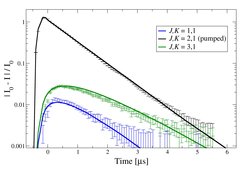Molecular Collisional Dynamics
In some cases within the interstellar medium, it is important to understand the low-temperature cooling of molecules not by purely radiative processes, which are relatively well-understood and well-modeled, but also by state-selective gas-phase collisions. In some cases, this can be modeled in a purely theoretical way, however, it remains a significant challenge for most systems and even impossible in some cases. It is thus important that laboratory experiments are used to either verify theory for challenging cases, or to provide the sole source of data for the impossible cases.
The most common way to study this in the laboratory is to prepare a well-defined gaseous mixture of a molecule of interested that is diluted in another gas in a well-conditioned environment, and to analyze the line profiles of its pure rotational spectrum as a function of a range of temperatures and pressures appropriate to interstellar conditions. For stable molecules, and stable collisional partners, this can be routine work. For unstable molecules, this can be nearly impossible.

We are also exploring the possibility of using the CP-FTS (Chirped-Pulse Fourier Transform Spectrometer) to study inelastic collisions and to derive state-to-state rate coefficients experimentally, by taking advantage of its fast, broadband pump-probe ability. In the vast majority of cases, rate coefficients are derived from numerical calculations and experimental studies are often missing. We apply complex pump-probe sequences to record the kinetics of rotational inelastic collisions. The thermal distribution of states is altered by the pump pulse that perturbs the population of the two rotational states involved in a single rotational transition. The resulting deviation from equilibrium is then propagated to other states due to resonant collisions and interrogated by probe pulses at different pump-probe delay times. State-to-state rate coefficients are estimated via the kinetics and reliably derived from pressure dependent measurements using a global fitting procedure.


